17 Foods High In Phosphorus
Phosphorus is an essential micro-nutrient you mainly need for proper bone and tooth health. These 17 foods are rich in phosphorus and you should make them a part of your everyday diet to avoid phosphorus deficiency.
What is phosphorus and why is it an essential nutrient?
Phosphorus is the second most abundant mineral in your body. This vital nutrient works closely with calcium to build stronger teeth and bones.
About 85% of your body’s phosphorus is present in your bones and teeth.
It is also present in smaller amounts in tissues and cells throughout the body.
Phosphorus helps in the filtration of waste through the renal system and plays a key role in the storage and metabolism of energy. It helps lower pain after a workout. Your body needs phosphorus for the maintenance, growth and repair of all cells and tissues, and in the production of DNA and RNA (1, 2, 3, 4).
Normally, people get required amount of phosphorus through their diet.
Natural sources of phosphorus include grains, milk, and protein-rich foods.
Symptoms of phosphorus deficiency include anxiety, loss of appetite, weak bones, stiff joints, irregular breathing, lethargy, irritability, and weight loss. In children, stunted growth and poor tooth and bone development may occur (5).
Having excessive phosphorus in the body is more frequent and more worrying than having too little. Raised levels of phosphorus are usually caused by kidney disease or by consuming too much dietary phosphorus and not enough dietary calcium.
Higher intake of phosphorus is associated with an elevated risk of cardiovascular disease (5).
A healthy individual requires 700mg/day of phosphorus, irrespective of whether they are male or female. The recommended daily allowance (RDA) of phosphorus (700 mg/day) is based on the serum levels of calcium. In children, the RDA of phosphorus is 1250 mg/day (6).
If you wish to increase your phosphorus intake, make these foods a part of your daily diet.
Whole wheat and bran mixes
Any combination of bran cereals or whole wheat items supplies a considerable amount of phosphorus into your daily diet, besides dietary fiber and other nutritional benefits. A single cup (130 g) of whole wheat provides 415 mg of phosphorus or 59% RDA (7).
It is an excellent source of dietary fiber, a single serving of whole wheat contains 15 g of dietary fiber (8).
It is also a wealthy source of manganese and selenium. What’s more, it is also low in saturated fat, cholesterol, and sodium.
Whole grains can be beneficial in lowering the risk of chronic diseases, such as diabetes, heart disease, and cancer. They also help in managing body weight and regulating gastrointestinal health (9).
However, you should avoid eating processed cereals that are rich in sugar as they might do more harm than good.
Add whole wheat cereals and bran flakes to your breakfast daily for boosting phosphorus in your diet.
Cottage cheese or cheddar
Cheese is also a powerhouse when it comes to phosphorus. One cup of diced cheese contains 676 mg of phosphorus, which is around 97% RDA of phosphorus (10).
It is a rich source of protein (33 g) and calcium (952 mg). But it contains a lot of saturated fat (28 g/ serving) (11).
Cheese is rich in calcium, which boosts the strength of bones and teeth (12).
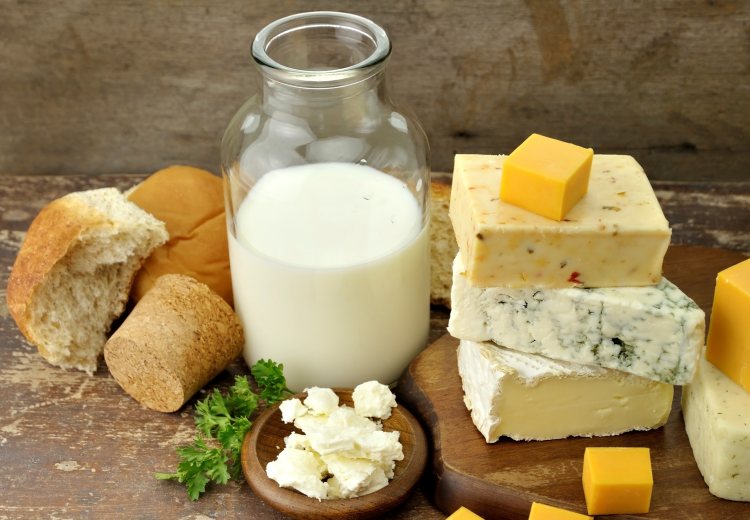
Dairy products and cheese are high in phosphorus
On the flip side, it is fairly high in cholesterol, which increases the risk of cardiovascular diseases (13).
To reap its nutritional benefits try adding a slice of cheese to your lunch sandwich or omelet.
Peanut butter
Peanut butter is a phosphorus and protein rich food.
Dieticians recommend natural, organic peanut butter instead of sweetened, fat-saturated varieties. A 100 g serving of peanut butter contains 358 mg of phosphorus (around 50% of RDA of phosphorus) (14).
It contains lots of manganese and niacin. Peanut butter is low in cholesterol and sodium (15).
Studies have shown that peanuts may protect against high blood pressure, diabetes, metabolic syndrome, and may be helpful in weight loss (16).
Make sure you are not allergic to peanut butter. Nut allergy is quite common and if you are not careful enough, nut allergy can lead to a life-threatening anaphylactic reaction.
Just spread some peanut butter on two slices of bread whenever you are in the mood for a light snack.
Corn
Whether canned or fresh, corn can be included in many meals.
One cup of corn provides 349 mg of phosphorus, which also translates to around 50% of the recommended daily intake of phosphorus (17).
Corn contains very little saturated fat and cholesterol (18).
Corn is a rich source of antioxidants which combat carcinogenic radicals (19).
People who are allergic to corn should not take it in any form. If you are using raw corn, you should wash it carefully to get rid of fertilizers or pesticides, possibly used in growing the crop.
You can add corn to soups, a variety of dishes or eat it directly on the cob.
Broccoli
Broccoli is also a phosphorus rich food. 100 grams of broccoli contain about 66.0 mg of phosphorus (around 9% RDA of phosphorus) (20).
It is a superb source of iron, protein, and calcium. It is rich in vitamin A (2130 IU), vitamin C (66.2 mg), folate (50.4 mcg) and potassium (231 mg) (21).
Broccoli contains very little saturated fat and cholesterol.
This vegetable is rich in health resources and contains disease-fighting antioxidants (22).
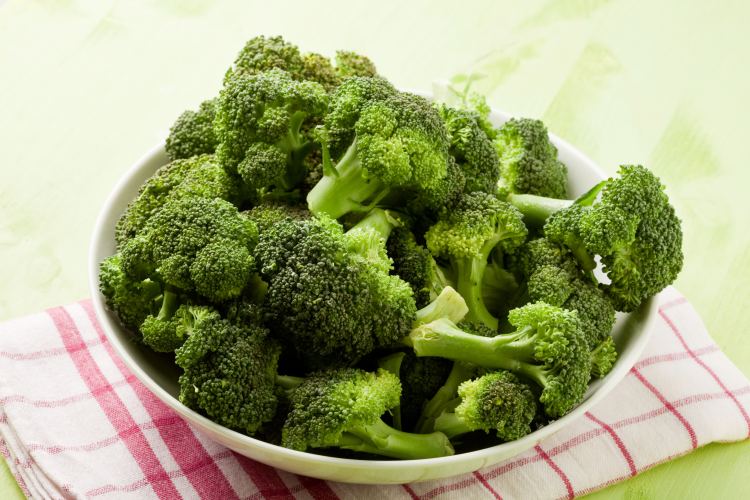
Fresh broccoli is high in phosphorus
Boil broccoli and add it to a meat dish or add it raw into a green salad to reap its benefits to the maximum.
Chicken
One serving of chicken contains 166 mg of phosphorus (around 24% RDA of phosphorus) (23).
It also contains other valuable nutrients such as protein (17 g) and niacin (6.6 mg). However, it is high in saturated fat (5 g) and cholesterol (73 mg) (24).
Consumption of chicken may reduce the risk of developing hypertension, obesity, heart disease or type 2 diabetes mellitus (25).
Excessive consumption may result in colorectal cancer, hypercholesterolemia and Salmonella infection (26).
You should also avoid eating chicken with its skin as it might increase your daily fat and cholesterol intake.
You may add chicken to your diet in various ways. Boil it, fry it, roast it or grill it. Make a soup or tasty sandwich for a light meal.
Garlic
Phosphorus is one of the many useful nutrients garlic supplies. One cup of garlic supplies 208 mg of phosphorus, which translates to up to 30% of your recommended daily intake of phosphorus (27).
It is also high in calcium (246 mg), selenium (19.3 mcg) and potassium (545 mg).
It has antihypertensive, antibiotic and antifungal properties. Different compounds in garlic are considered to decrease the risk of cardiovascular diseases.
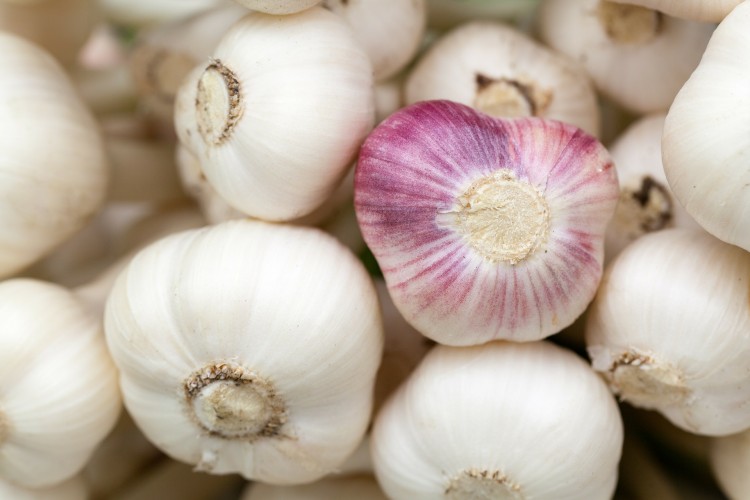
Garlic is rich in phosphorus and other nutrients
It also enhances immunity (28).
But tread lightly while consuming garlic; adverse effects, including body odor, smelly breath, dermatitis, bleeding, and flatulence, have been reported (29).
Add crushed garlic to your daily diet by including it in your cooked meals. You can also eat it raw.
Nuts
In addition to peanuts, other nuts such as Brazil nuts, almonds and cashews all contain a good amount of phosphorus.
These nuts, in dried and non-perishable forms, can be a good source of getting nutrients such as phosphorus into a diet when food storage is difficult.
One ounce serving of nuts contains 166 mg of phosphorus (around 24% of your RDA of phosphorus) (30).
They are also rich in potassium (185 mg) and magnesium (81.8 mg) (31).
Cholesterol and sodium content is low.
Consumption of nuts may reduce the incidence of cardiovascular disease and gallstones in both genders and diabetes in females. Research studies have shown that nut intake has a cholesterol-lowering effect (32).
If you are allergic to nuts, do not consume them in any form. As mentioned before, eating nuts you are allergic to, may lead to allergy and even life-threatening anaphylaxis (33).
For a phosphorus boost, eat a handful of nuts every day.
Chocolate
A bar of quality dark chocolate contains 208 mg of phosphorus (around 30% of the RDA of phosphorus) (34).
It is also rich in calcium (189 mg) and potassium (372 mg).
The downside of chocolate is its high content of saturated fat (19 g) and sugars (51 g) (35).
Chocolate is useful in reducing effects of aging, oxidative stress, regulating blood pressure, and atherosclerosis (36).
If you eat chocolate excessively, you run a higher risk of dental caries, acne, obesity, high blood pressure or diabetes (37).
You should eat dark chocolate and should avoid the chocolates with added sugar as those chocolates would do more harm than good by loading your body with unwanted sugars.
Munch on a bar of chocolate every day for a sweet treat. You can also make chocolate-based desserts or could add chocolate to your drinks, smoothies, or shakes.
Salmon
Salmon is an excellent and healthy phosphorus-rich food. You'll get a considerable portion of your daily phosphorus supply from just a single serving of your favorite fish.
A 100 gram serving of salmon contains 200 mg of phosphorus (around 29% of the RDA) (38).
It also has a high potassium (490 mg) and protein (20 g) content.
Being a fatty fish, it is high in cholesterol (55 mg/ 100 g serving) (39).
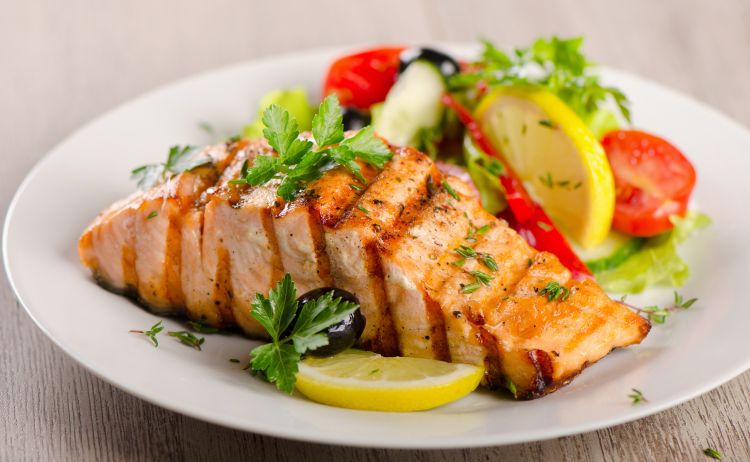
Salmon is rich in phosphorus and other essential nutrients, such as omega-3 fatty acids
This fish has anti-inflammatory effects (40).
It helps manage body weight and has been found to assuage symptoms of depression and shield fetal brain health during pregnancy.
It decreases the risk of dementia.
However, make sure the fish you eat is fresh and free of contaminants like mercury.
Eating a salmon rich in mercury is particularly dangerous among pregnant and breastfeeding females.
Grill a fillet of salmon and garnish it with lemon or olive oil and add it to a green salad.
Clams
Shellfish (such as clams) contain loads of nutrients and minerals. A single cup of clams supplies your system with 384 mg of phosphorus (41).
A cup of clams also supplies 29 grams of protein, 49% of the DV for vitamin C and a massive 176% of the DV for iron (42).
On the other hand, clams are rich in cholesterol (77 mg/serving), which may have adverse effects on your health.
Clams have been known to raise the level of heart-healthy HDL cholesterol in your body (43).
Even though there are real concerns about mercury and toxins in clams, the benefits of consuming clams far outweigh the risks (44).
You should avoid eating clams if you are suffering from hypercholesterolemia. You should also avoid eating clams if you have an allergy to shellfish.
Grill some clams, season them with extra-virgin olive oil and add them to a seafood broth or seafood salad.
Tomatoes
Tomatoes are a rich source of phosphorus.
A cup (of chopped tomatoes contains 43.2 mg of phosphorus (around 6% RDA) (45).
They are also a good source of vitamin E, niacin, thiamin, vitamin B6, iron and copper, and a valuable source of dietary fiber, vitamin C, vitamin A, vitamin K, manganese or potassium.
On the other hand, they are high in sugar (5 g/ cup) (46).
Tomatoes contain a biologically active substance lycopene, which has been known to have antioxidant, hypolipidemic, and anticarcinogenic properties (47).
Their excessive use may result in dietary complications and heartburn in those individuals with gastroesophageal reflux disease, also known as GERD.
Canned tomatoes contain a lot of sodium, which may also have adverse effects on health (48).
Tomatoes are rich in an ingredient called lycopene.
Lycopene is a natural antioxidant. It can also save you from different sorts of cancer, like prostate cancer, and could save you from cardiovascular disease as well (49).
Tomato is a key ingredient in many popular dishes; you can also consume it in raw form in salads.
Potatoes
One potato contains 210 mg of phosphorus (around 30% RDA of phosphorus) (50).
They also contain 1554 mg of potassium and 72.7 mg of vitamin C. They have high starch content; (68 g carbohydrates and sugars 3 g) (51).
Potatoes are a good source of minerals, vitamins and dietary fiber (52).
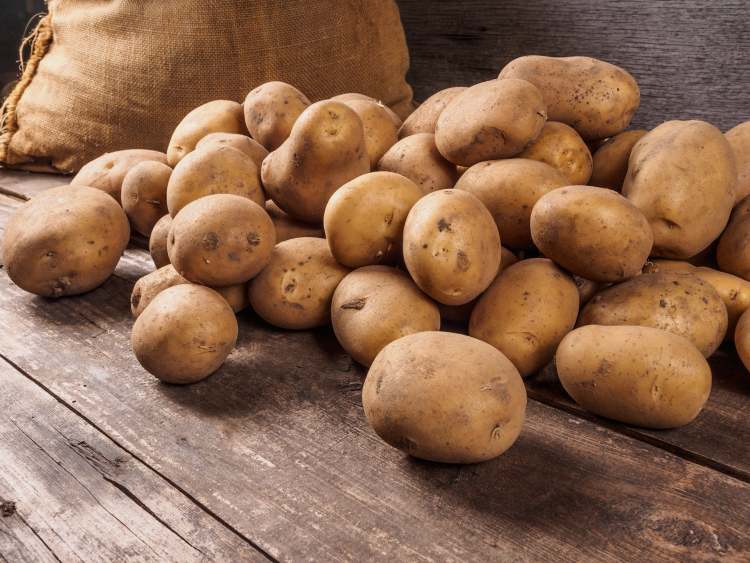
Potatoes are high in phosphorus and other essential nutrients
However, excessive consumption increases the risk of cardiovascular disease and type-2 diabetes.
Make a tasty potato salad with butter and garden cress or add roasted potatoes to a hearty meal.
Milk
Dairy foods are good dietary sources of phosphorus. In addition to other nutrients, milk is also a rich source of phosphorus.
One cup of milk gives you 286 mg of phosphorus, which translates to around 41% of the RDA of phosphorus (53).
If you are lactose intolerant can take soy milk as an alternative. Milk contains 41% calcium and 9% vitamin A (54).
Non-skimmed milk is high in saturated fat (11 g/serving).
Milk has many nutritional benefits; it makes bones and teeth stronger (55).
Excessive use of non-skimmed milk may increase the risk of heart disease and diabetes (56).
Drink a glass of milk daily for adding phosphorus to your diet.
Red meat
Beef is perhaps the most phosphorus-rich food. 100 g of this red meat contains 175 mg of phosphorus (around 25% of the RDA of phosphorus) (57).
Red meat is also rich in potassium (289 mg) and niacin (4.8 mg). It has a high cholesterol (62 mg) and fat (13 g) content (58).
Folate and iron present in red meat are beneficial against anemia. Beef helps in improving the health of red blood cells. It also promotes healthy brain functioning and the normal production of hormones (59).
The high-fat content of red meat is damaging for cardiac health and disproportionate consumption of red meat may lead to cardiac disease and colon cancer (60).
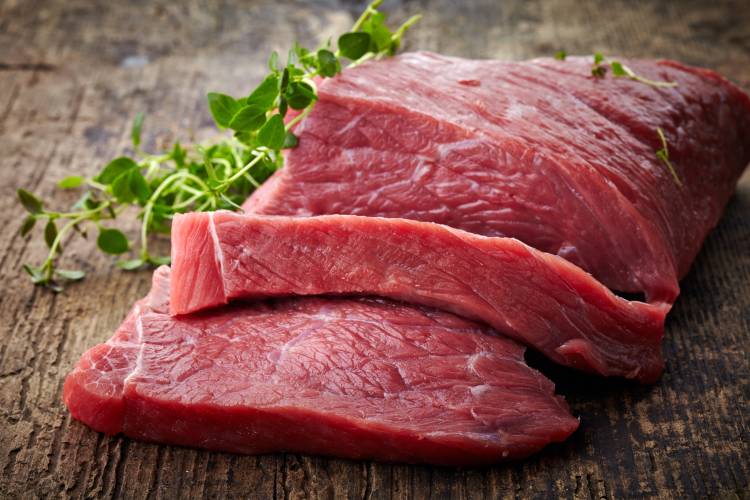
Beef meat is rich in phosphorus
Beef is a popular part of many cuisines; roast a steak on a sunny day outside and enjoy with vegetables for a phosphorus-rich meal.
Eggs
Eggs are a good source of phosphorus. One large egg contains about 95.5 mg of phosphorus (61).
Eggs are a high dietary source of protein (6 g), vitamin B12 (0.6 mcg) and selenium (15.8 mcg). They have high cholesterol content (211 mg/serving).
Besides being rich in phosphorus, eggs are an economical, high-quality source of protein (62).
They boost muscle strength, are a powerhouse of energy and make hair shinier and healthier. Due to their high-cholesterol content, patients at cardiovascular risk should consume them moderately (63).
Scramble, boil or fry an egg every day for breakfast.
Yogurt
Yogurt is among the healthiest food items. One cup of plain yogurt provides you with almost 233 mg of phosphorus (around 33% of the RDA of phosphorus) (64).
Yogurt is also a brilliant source of calcium (296 mg), potassium (380 mg), and vitamin D (65).
This dairy item is high in saturated fat (5 g/serving).
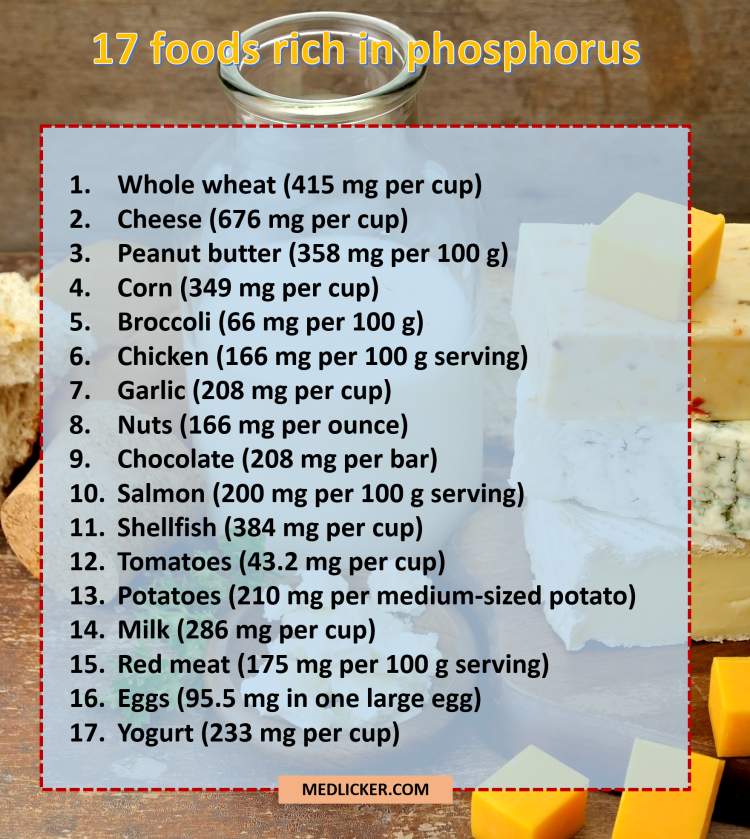
Food high in phosphorus
Yogurt regulates the digestive system and fights osteoporosis by making bones healthier (66).
If you are worried about the fat content in yogurt, use non-fat yogurt instead.
Eat a bowl of plain, non-fat yogurt daily to boost phosphorus intake.
Things to remember
Phosphorus is a vital nutrient when it comes to boosting the health of bones and teeth.
So if you want to increase your phosphorus intake, add poultry, seafood, and dairy items to your diet.
People allergic to food items such as shellfish and nuts should opt for alternative dietary sources of phosphorus, such as dairy products.
If you have a history of heart disease, avoid consumption of red meat and add lean meat such as chicken or turkey to your diet instead.
If you are on a weight-loss diet, go for fat-free or skimmed dairy items.
Green vegetables such as broccoli and whole wheat cereals are safe, side-effect free, sources of phosphorus.
Also, do not eat foods rich in phosphorus if you are suffering from a kidney disease or have raised phosphorus levels in your blood. In such case, go and see your doctor and ask for proper examination and treatment of your underlying disease.
| Written by: | Michal Vilímovský (EN) |
|---|---|
| Education: | Physician |
| Article resources: | See numbered references in the article. |
| Image resources: | Stockphotosecrets.com |
| Published: | March 18, 2017 at 1:17 PM |
| Last updated: | March 19, 2017 at 12:40 PM |
| Next scheduled update: | March 19, 2019 at 12:40 PM |
Get more articles like this in your inbox
Sign up for our daily mail and get the best evidence based health, nutrition and beauty articles on the web.

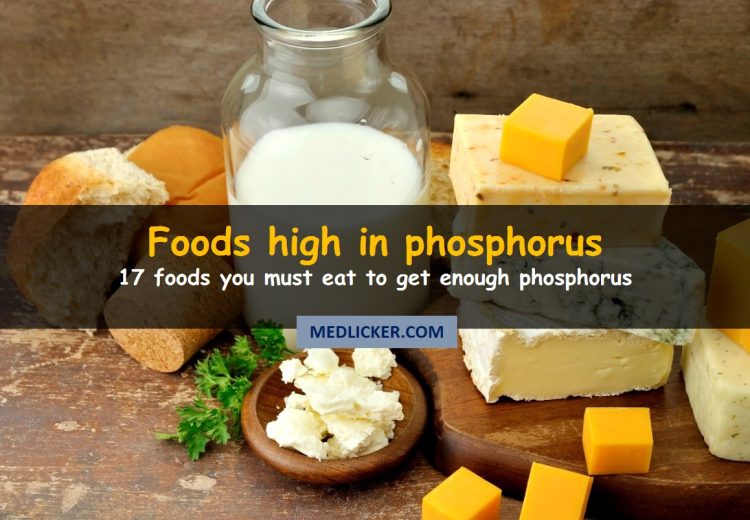
Ache in left arm that you should not ignore
Alkaline water dangers: why you should not drink it
How to Avoid Sleepiness While Studying?
23 Foods That Increase Leptin Sensitivity
Low dopamine (e.g. dopamine deficiency): causes, symptoms, diagnosis and treatment options
Swollen taste buds: the ultimate guide to causes, symptoms and treatment
Thin endometrial lining: causes, symptoms, diagnosis and treatment
Pimples inside nose: the complete guide
Holes in tonsils: definition, symptoms, treatment and prevention
How to deal with an ingrown hair cyst
Allegra vs. Zyrtec vs. Claritin
Allergy to penicillin and alternative antibiotics
How to get rid of phlegm (excessive mucus) in throat? Detailed guide to medical and home remedies, symptoms and causes
What causes stomach ache after meals?
Liver blood test results explained